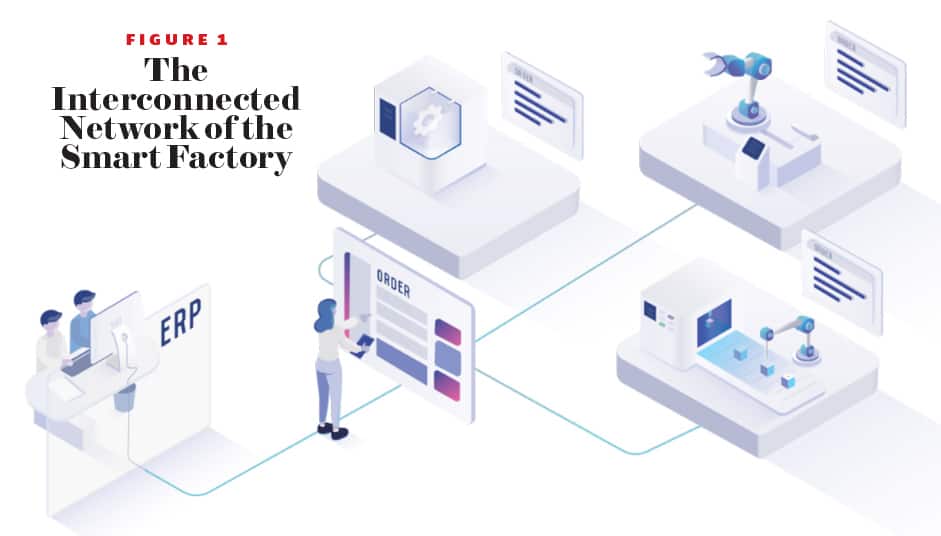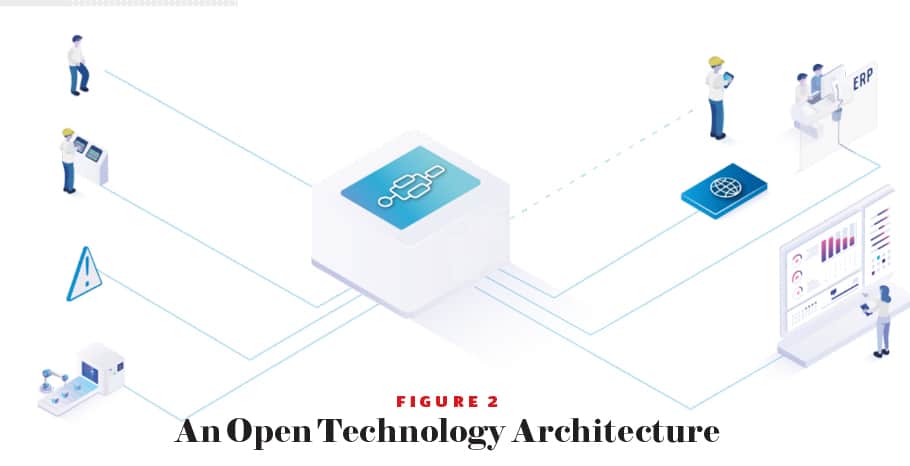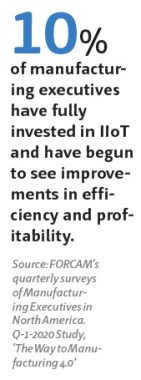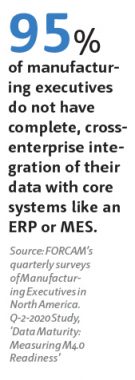
How resilience strategies can help manufacturers survive and thrive. By Thomas Luck, Robert Zepernick, and Sandy Abraham

Today’s cutting edge technologies provide a wealth of opportunities for keen business leaders to optimize their production systems. But with those opportunities come a multitude of security and resiliency concerns. Gone are the days of decoupled and siloed business operations. Businesses today must integrate an empowered workforce with production automation and data transparency to thrive in the face of uncertainty.
Proper use of technology can provide an essential feedback loop for monitoring complex manufacturing systems, keeping them robust and resilient to disruptive forces. This level of monitoring can allow manufacturers to vary or diversify their production mix intelligently, align production goals across the organization, and closely monitor production metrics in real time. Ultimately, it’s not the immediate efficiency wins that businesses should develop, rather it’s the long-term resiliency goals reinforced with data-driven technologies that accelerate sustainability. Organizations that balance these priorities will have the capacity to survive, adapt, and flourish in stressful conditions.

Bouncing back from disruption is not enough – a successful and truly resilient organization should strive to gain a competitive advantage while navigating through the turbulence.
What Does it Take to be Resilient?
Many companies are looking for ways to do more with less. But efficient companies are not necessarily resilient, nor are they always prepared to operate with agility. Businesses must undergo a comprehensive digital transformation to identify the real potential and productivity of their resources.
However, for many, resilience means merely having the ability to bounce back from disruptions – that is, returning to the status quo and minimizing the negative impacts on revenue generation and operating costs. But these companies are missing the bigger picture – resilience should be thought of as enterprise systems and the comfort they provide through prescribed processes that incorporate contingency and risk management to insulate company margins. Organizations that fully embrace resilience as an operating ethos can develop agile processes and tools that allow them to rebound from setbacks and move forward to gain competitive advantage and survive tumultuous times.
Raising the level of productivity is critical for manufacturing companies, especially in industrialized nations. It should come as no surprise that most manufacturers incorporate Lean Management philosophies to reduce waste and maximize productivity. However, this process-based practice focuses on asset efficiencies which can make businesses inflexible and less resilient to market disruptions. When viewed holistically, the forces of efficiency and resiliency tend to pull in opposite directions. But technologies like advanced supply chain planning, demand planning, manufacturing execution, predictive scheduling, and relationship management are vital tools that offer that much needed balance.

The Fourth Industrial Revolution and the introduction of the Industrial Internet of Things (IIoT) and its technologies — the seamless connection of humans to humans, humans to machines, machines to systems, and systems back to humans – have become essential elements of resilient business design. This is better known as Smart Manufacturing, which generates powerful insight to streamline business practices and deliver important results, including reduced costs, higher productivity, greater agility, and improved flexibility across the enterprise. The emphasis is on bringing ideas together as well as machines.
Most manufacturers strive for a seamless connection of things – or the connection of people, systems, and machines in terms of the way everything should operate inside and outside the plant. While everyone is talking about Digital Transformation, few have completed the task.
Resilient Design Promotes Smart Manufacturing Culture
The pathway to a Smart Factory and manufacturing resilience begins with information transparency across the enterprise. The enterprise is made up of an interconnected network of relationships between employees, intelligent systems, and connected machines. The challenge is that each part of the manufacturing ecosystem has a different set of rules by which they operate:
- Humans are thinking, breathing, and feeling creatures. They can be inconsistent, error-prone, and challenge existing rules. But they also can adapt and rapidly find solutions to complex situations.
- Machines have moving parts, but no innate intelligence. You can add a sensor to a machine to tell you what’s wrong with it, but it will still operate based on the laws of physics and not man’s rules. Unlike humans, machines don’t have good days or bad days.
- Systems are nothing but innate intelligence. They operate by a fixed set of data-driven rules and are rigid in the way those rules are interpreted. Traditionally, systems tend to be brittle and inflexible to systematic disruptions.

There are often many disparate technologies coexisting within a business, which are commonly disconnected and only partially utilized. Custom integrations can be costly to develop and become liabilities as components evolve and modernize. For example, one manufacturer, mired with hundreds of disparate systems that were incompatible or redundant, discovered that the best way to move transactional data through their B2B process was to import, edit, and export each transaction with a spreadsheet. This is a common solution when enterprise systems become too complex and wieldy. But while these patchwork solutions are easy to implement, they’re ultimately inefficient.
Businesses must be able to rapidly adapt to the changing needs of their customers and unforeseen market conditions. This requires agile redeployment of assets and appropriate visibility into the manufacturing process to identify bottlenecks, low asset utilization, and subpar performance and quality.
Identifying these weaknesses and adapting quickly is the essence of resilient manufacturing. These efforts extend far beyond traditional risk management and risk mitigation techniques to ensure companies respond while continuing to move forward. Bouncing back from disruption is not enough – a successful and truly resilient organization should strive to gain a competitive advantage while navigating through the turbulence.
An Open New World
Many systems operate well in isolation but struggle to integrate and fail to support a resilient environment. Federal Emergency Management Agency (FEMA) defines interoperability as the “ability of systems, personnel, and equipment to provide and receive functionality, data, information, and services to and from other systems, personnel, and equipment… in a manner enabling them to operate effectively together.”
An open technology architecture provides the ability to integrate a portfolio of technologies into a single, coherent system that is both efficient and resilient. The integration of business data from production and planning and various factory locations helps to achieve increased productivity, cost savings, tightened security, and improved environmental impact.
A Smart Manufacturing solution should incorporate an extensible architecture that is built upon an open application programming interface, or API, that provides flexibility to interconnect disparate systems. This interface should allow for the efficient exchange of data and provide the appropriate toolset for engineers to develop additional system integrations easily.

Transparency is the harmonizing force that brings purpose and unity to each role, agility and adaptability to the business, and resiliency as a competitive advantage.
In an OpenAPI world, there’s no need for a single supplier of hardware and software – such a world rarely exists anyway. Most manufacturing plants have as many types of equipment suppliers as they do people. The long-standing challenge of networking these machines has become easier in recent years due to advances in software networking and an understanding in the industry that it’s simpler for end users if systems can talk to one another with no barriers. Or as FEMA said at the outset, “…in a manner enabling them to operate effectively together.”
This powerful ecosystem of interoperative systems and machines needs to begin with humans. It also requires the information technology (IT) and operations technology (OT) teams to agree upon an operational matrix that ties together the value stream with intelligent business systems.
The success of such interoperability is a reduction in maintenance and operations costs, a tighter, more nimble supply chain, a transparent business system, and a safer and more profitable plant. That kind of success comes with IIoT, where the best ideas join together to create an open and resilient business design that overcomes economic doldrums.
Traditional manufacturing technologies include enterprise resource planning (ERP) and materials resource planning (MRP). The next generation of technologies, and those that are most conducive to resilient design, include manufacturing execution systems (MES), enterprise asset management (EAM), and advanced supply chain planning (ASCP). Additional edge products include strategic network optimization (SNO), demand planning, and predictive maintenance scheduling. All these systems should coexist within a business enterprise and work in concert to tie together critical manufacturing information.
The promise of the Manufacturing Execution System (MES), for example, is to streamline data management, deliver knowledge throughout the enterprise, and provide a window into a plant’s true operational state. This system can also produce a digital twin model of the manufacturing process to simulate weaknesses and proactively prepare for vulnerabilities. Its ability to share vital manufacturing data across the organization in real time promotes efficient manufacturing and resilient design.



While a conventional MES does not provide this networking capability, an OpenAPI can fully integrate the functionality and allow it to be accessed like any other tool as part of the ecosystem. This ecosystem or platform economy is a modern construct from the new era of IIoT that acts as a performance technology bridge connecting and passing data packages between two network segments using the same communication protocol. Therefore, the OpenAPI is the perfect and modern answer to connectivity problems on the plant floor.
But accommodating this type of transformational change is difficult for most organizations. This is especially the case for organizations that have not yet started their resilience journey. And much like a rubber band that stretches and returns to its original form, transformational changes often spring back to the old ways of doing things. This may be caused by bureaucratic resistance, employee pushback, or even sabotage. Any significant change initiative requires strong leadership, starting with senior executives and resonating down through the organization, as well as transparency, understanding, and trust at every level.
The Path to Manufacturing 4.0 and Company-wide Resilience
An organization’s ability to rally the workforce around common benchmarks and gain buy-in from every level of the manufacturing process will often be the determining factor of success when operating under stressful conditions.
Not only can manufacturing data tell you about company performance, it also has the power to drive engagement and align employees with the same goal. The pursuit of improvement and the maturity to use data effectively can take many forms in the beginning stages of the digital transformation. Using a combination of computerized visualizations to circulate manufacturing metrics and manual production boards to showcase manufacturing targets and related goals are effective approaches to disseminating crucial information. Ultimately, aligning the workforce around these metrics and reacting quickly to changing production demands will help insulate the company from disruptive forces.
Whether a company has advanced manufacturing technology today or is considering implementing it in the future, many factors should be considered to sustain and flourish in turbulent environments, including:
- Focusing on real-time data collection to promote resilient, agile production processes
- Ensuring proper integration of technologies to standardize around a single source of truth – this is especially the case with business-centric data that originates on the factory floor
- Following Lean Design concepts when deploying technology-related processes to limit duplication of user effort – for example, operator input should be automated and executed only once to limit redundancy and user error
- Leveraging key technologies to provide transparency and automation within the organization to react quickly and efficiently to industry shocks
Long-term business success is not just a function of profitability; instead, it hinges upon a company’s ability to adapt in times of change and conservatively use its capital. Adoption of Manufacturing 4.0 and related technologies can be the key enablers for achieving company-wide resilience. M